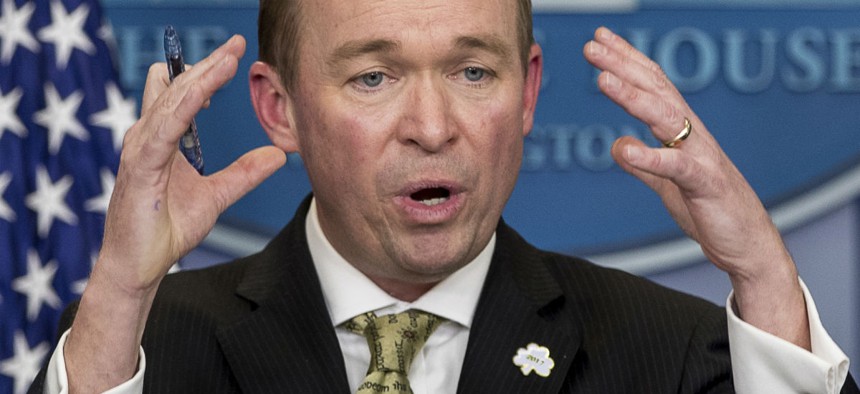
Budget Director Mick Mulvaney discusses President Donald Trump's spending plan at the White House on March 16. AP Photo/Andrew Harnik
Trump’s Big League Management Agenda
Using mission to drive strategy makes eminent sense, but there are many ways to game the strategy.
President Trump has rolled out a very big management agenda. You could even call it big league, if not bigly. But what’s really new here?
No administration has ever bitten off quite so much with its management plan. The guidance that OMB Director Mick Mulvaney sent to the heads of executive agencies is an ambitious challenge to rethink agency missions, the workforce needed to fulfill them and the performance measures to chart success. All these pieces will be rolled into the 2019 budget, which the administration will assemble in the fall and announce early next year. That’s a huge undertaking.
It’s also a big deal because of what’s not in Mulvaney’s memo. In its first days, the president imposed a hiring freeze that was to be replaced, he said, with a plan to reduce the workforce by attrition. The word appears nowhere in the memo. More-seasoned heads prevailed.
In its place is a sophisticated strategy, one that challenges agency officials to first define their mission, and then base the workforce, organizational structure, performance metrics and budget around that mission. Ask a room of government experts how to tackle these issues and there would be vast support for such a mission-driven approach.
The Clinton administration’s “reinventing government” effort rivaled Trump’s effort in its scope. REGO promised to reduce the workforce by 250,000 employees, pare down regulations, and cut spending by more than $100 billion. That’s some serious swamp-draining. But Trump’s initiative has the potential to affect more programs—putting more jobs on the line and cutting more spending.
Unlike the Clinton effort, OMB is driving Trump’s agenda. Mulvaney’s memo has no targets, either for the workforce or spending cuts. The “skinny budget” has already been declared comatose, but it gives an unmistakable signal that the administration has historic cuts in mind. Reinventing Government was ambitious, for sure, but it aimed primarily at making existing programs work better. Mulvaney’s plan aims to completely wipe out some programs (the National Endowment for the Arts and the Corporation for Public Broadcasting, for example) slash others (the Environmental Protection Agency), and boost others (Defense and Veterans Affairs).
So it’s not only a big deal in terms of its bite. It’s a big deal in terms of its breadth. And for the first time, it pulls together the analytical threads—strategy, structure, metrics, and budget—into the single package many experts have long supported, and which the Government Performance and Results Modernization Act envisions.
On paper, Trump’s plan to make mission drive strategy is impressive. But will the battle plan survive its first contact with the Washington swamp that Trump wants to drain?
As he’s already discovered with health reform, doing this is a whole lot harder than it looks. The deep realities of government programs can quickly undermine sweeping rhetoric.
He’s got only a handful of his appointees in place. The Mulvaney memo requires a lot of heavy lifting on a very short schedule—agencies owe OMB the outlines of their plans in June. Team Trump doesn’t have a lot of loyalists in place to drive the process. Career officials worried about their jobs, defensive of their programs, and fueled by angry interest groups can put a thousand boulders in the road to slow their agencies’ response.
The basic approach of using mission to drive strategy makes eminent sense. Good analysts, however, can easily do exactly the reverse, deciding first what results they want and writing plans to justify decisions already made. The mind boggles at ways the strategy can be gamed.
And without clear targets in the guidance, many officials aren’t sure where to set their sights. That’s likely to lead to weak-tea cuts that fall short of the serious swamp-draining that the administration promised.
Clearer targets are, of course, likely to emerge in the coming weeks, as Mulvaney and his team settle into OMB. And it’s also likely that he’ll give agency leaders a quick look at the bat behind his door, along with a not-so-subtle signal that they can make the cuts—or that OMB will do the job for them.
Still, the Trump management agenda is unmistakably a big deal. It’s sweeping and comprehensive. It gives agency leaders the tools to make big changes, driven by mission, that are far more sensible than hiring freezes, reductions through attrition, or across-the-board cuts. At least on paper, it demands that they hold themselves accountable through performance metrics that everyone can see.
But at the core of the Trump strategy is an important fact. Clinton’s reinventing government effort was more of a top-down effort, driven by clear targets for downsizing and focused on a relatively smaller bite of the federal government. Trump’s effort will, inevitably, be more bottom-up, with all agency leaders responsible for producing their own plans within the very broad Mulvaney framework.
The bigger the bite, the more the results depend on what happens down the bureaucratic food chain. Trump’s management agenda has an unprecedented level of ambition. To pull it off, he’s going to need agency leaders across government to be fully engaged and on board.
And that could be where the sluggish pace of political appointments comes back to bite the administration. A big-league strategy without big-league players won’t produce bigly results.
Donald F. Kettl is a professor and former dean of the University of Maryland School of Public Policy.







